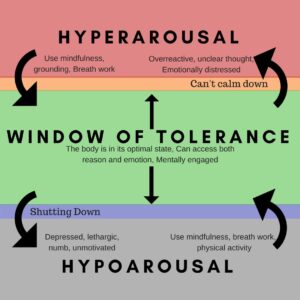What is the window of tolerance exactly? Before you can learn to be aware of and remain inside your window of tolerance, you need to understand what the window of tolerance actually is. It’s a concept named by renowned psychiatrist Dan Siegel. He defines the window of tolerance as the optimal zone of “arousal” for a person to function in everyday life. When a person is operating in this window, they can effectively manage and cope with their emotions.
The window of tolerance is when we are able to think clearly. Imagine your brain as a computer that it is online and connected to all your systems. You see being inside your window of tolerance implies that your body is in a state of equilibrium. You are breathing regularly. Your temperature is normal. Your blood pressure is where it is supposed to be. Even your digestion is working right. Your brain impacts your body and vice-versa. Being inside your window of tolerance means you are in the best state to manage feelings, emotions, thoughts, problems, and even conflicts. Problems arise in this state, but you are able to problem solve and remain present and connected to your feelings.
FACES
Dan Siegel invented the acronym FACES to describe what it means to be inside your window of tolerance. F stands for flexible. You are able to act and think flexibly. A is for adaptive meaning you are able to shift if necessary in your thinking, behaviors, and expectations. C represents coherent meaning that your brain is able to communicate effectively and clearly. E means energized implying you have sufficient stamina and resilience to manage your daily tasks. And the S stands for stable. Pretty great place to be!
Baby
Like most things, our window of tolerance is developed early in life, when we are babies. Our caregivers shape and form our window of tolerance. We learn from them directly. When we cry, we are soothed, our nervous systems are calmed, and we are back to that sweet spot of calmness we are calling the window of tolerance. When an infant’s needs are met, they feel safe, their heartbeat is regular, their breathing is calm, and their brains are given the chance to grow like crazy.
 Dysregulated
Dysregulated
If you are not inside your window of tolerance, you slowly begin to feel agitated, irritable, anxious, shut down, and unsafe. It’s a process that typically doesn’t happen all at once. We call this emotional dysregulation. It’s the temper tantrum, the meltdown, the checked-out state, the constantly anxious person. This is what happens when we leave our window of tolerance. Our brains and bodies are constantly talking to create our current emotions. We will examine how trauma changes our windows of tolerance in the next article. Remember, though, no one stays inside their window of tolerance all the time no matter how wide it may be. We all drift in and out of it and become anxious and upset. But depending on one’s past, upbringing, experiences with trauma, everyone’s window of tolerance is unique.
Hyper-arousal or Hypo-arousal
When a person leaves their window of tolerance, they can go to one extreme or another. Hyper-arousal is that fight or flight response; typically including anger, tears, panic, and fear. A person’s nervous system is on high alert, even without the presence of a visible threat. Definitely not in that window of tolerance. Then there is the other direction: hypo-arousal; this is the opposite; that shut-down state or being checked out. Typically when someone is in hypo-arousal, they appear numb, zoned out, depressed, listless, as if no one is home. This person’s nervous system has too little arousal. The most extreme version of this state is called dissociation. We don’t consciously choose which direction to go in when we get dysregulated. It is usually based on one’s growing up experiences, the amount of stress experienced, one’s genetic makeup, and upon one’s learned defense mechanisms.
Awareness
Of course there are many ways to learn how to widen your window of tolerance and to stay within it. The first step begins with awareness. Awareness comes from learning what the window of tolerance is. Next, observing when you are in your window of tolerance and when you start to veer out of it. Noticing which direction your body typically moves when it becomes dysregulated is the next step. This knowledge is key to making changes. Keep reading this newsletter to learn more concrete ways to enlarge and then stay in your window and to teach your children how to stay in theirs.





